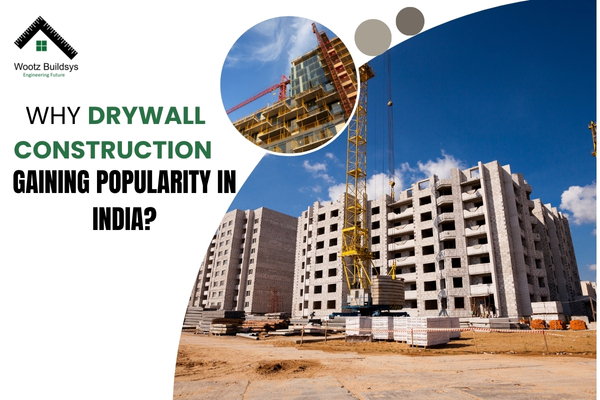
India’s construction landscape is rapidly evolving, with urbanization, infrastructure expansion, and changing lifestyles creating a demand for faster and more efficient building methods. Drywall construction, an innovative building technique used extensively in developed countries, is now gaining recognition and momentum across Indian metropolitan cities and growing towns alike. But what is driving this wave? Let’s explore why drywall is being adopted at a record pace and why it is likely to become the norm in Indian real estate.
What Is Drywall Construction?
Drywall construction involves using prefabricated panels, usually made of gypsum plaster sandwiched between paper sheets, for creating interior walls, ceilings, partitions, and other architectural elements. These panels replace traditional brick-and-mortar or cement plaster walls and are installed with screws, metal frames, or adhesives after the main building structure is complete.
Key Features of Drywall Construction
- Lightweight, easy to handle, and quick to install.
- Superior finish, ready for painting or design treatments.
- Various types: Regular, moisture-resistant, fire-resistant, and soundproof.
- Reduced labor and material consumption compared to conventional walls.
Why Is Drywall Construction Excelling in India?
1. Speed of Construction
Time is money, especially in the Indian real estate sector. Drywall construction significantly cuts down on project timelines. A wall that would take days or weeks to build with bricks and mortar can be completed in hours using drywall. This speed is crucial for meeting aggressive deadlines in commercial buildings, malls, hospitals, hotels, and housing projects.
2. Labor and Cost Savings
With rising labor costs and a perennial shortage of skilled masons and workers, builders are seeking alternatives that require less manpower. Drywall systems are designed for swift assembly, reducing both labor requirements and onsite supervision, ultimately making the project more cost-effective.
3. Superior Finish and Versatility
Drywall panels offer a smooth, even surface that’s instantly ready for painting, wallpapering, or decorative finishes. They allow for complex architectural features like curves, niches, and suspended ceilings—attributes highly valued in modern Indian homes and offices.
4. Sustainability and Environmental Benefits
Traditional construction relies heavily on sand, water, and cement—natural resources under severe stress in India. Drywall construction consumes far less water and virtually no sand. Most panels use recycled content and can be recycled again at the end of their lifecycle. With green certifications becoming more important in Indian architecture, drywall’s eco-friendly nature is a huge plus.
5. Design Flexibility and Space Efficiency
Drywall partitions are thinner than brick walls, thereby saving valuable floor area—crucial in cramped urban spaces. What’s more, they can be removed or relocated easily, allowing for flexible layouts as family or business needs change.
6. Fire, Moisture, and Sound Resistance
Special drywall types offer enhanced fire protection (up to 4 hours), moisture resistance for bathrooms and kitchens, and even strong acoustic insulation. This versatility makes them ideal for schools, hospitals, hotels, multiplexes, and high-end apartments.
7. Cleaner and Safer Construction Sites
Drywall construction generates less dust, noise, and waste compared to conventional methods. Site cleanliness is appreciated not just by workers, but by neighbors and local authorities, reducing negative community impact.
Use Cases: Where Is Drywall Construction Making an Impact in India?
- High-rise apartments and luxury homes: For faster fit-outs, customized partitions, and high-finish designs.
- Commercial spaces: Offices, malls, and cineplexes, where speed and interior quality are essential.
- Hospitals and educational institutions: Soundproof or fire-rated drywalls in sensitive areas.
- Hotels & hospitality sector: Flexible layouts, rapid renovation cycles, and enhanced aesthetics.
- Renovation/retrofitting: Quick upgrades with minimum disruption in existing occupied spaces.
Drywall vs. Traditional Wall Construction
| Feature/Factor | Drywall Construction | Traditional Brick/Cement Wall |
| Installation Speed | Very fast (hours/days) | Slow (days/weeks) |
| Weight | Lightweight | Heavy |
| Material Use | Minimal water, no sand needed | High sand and water requirement |
| Finish Quality | Smooth, ready for decoration | Requires plastering/curing |
| Flexibility | Easily modified or removed | Permanent |
| Fire Resistance | High (with special panels) | Good (brick is naturally fireproof) |
| Sound Insulation | Excellent with specific panels | Moderate to good |
| Cost | Competitive, often cheaper | Increasing due to labor/material |
| Environmental Impact | Low waste, recyclable | High waste, difficult recycling |
The Indian Market Trend: Growth and Acceptance
The drywall market in India is growing at an estimated double-digit rate, with major cities like Mumbai, Delhi NCR, Bengaluru, and Hyderabad leading the way. Every year, more builders, architects, and homebuyers are opting for drywall solutions over brickwork, thanks in part to:
- Increasing awareness about faster, sustainable building methods.
- High-profile projects (like airports, malls, and IT parks) adopting drywall technology.
- Major manufacturers investing in product awareness and installer training.
Common Myths About Drywall Construction in India
- “Drywalls are weak or ‘temporary’.”
Indian gypsum boards, when installed with certified systems, meet international load and impact standards. - “They aren’t suitable for Indian weather.”
With options tailored for humidity, heat, and even seismic zones, modern drywall is robust and adaptable. - “They’re only for offices or luxury homes.”
Drywall is now found in mid-range housing, schools, clinics, and even affordable housing projects.
Practical Advice for Indian Homeowners and Developers
- Choose reputable suppliers and licensed installers.
- Discuss design flexibility upfront with your architect—drywall allows easy tweaks even midway through a project.
- Consider specialty boards (like moisture or fire-resistant) for kitchens, baths, and shared walls.
Real-World Success Stories
- Delhi Airport T3: Used drywall extensively, resulting in on-time completion and high architectural finish.
- Grand Hyatt Gurgaon: Drywalls enabled fast, premium-room fit-outs for a major hospitality project.
- Multiple IT parks and hospitals throughout southern India have adopted drywalls for speed, hygiene, and ease of future expansion.
The Road Ahead
With its blend of speed, efficiency, modern aesthetics, green credentials, and adaptability, drywall construction is set to become the method of choice for innovative Indian buildings—be it residential, commercial, or institutional. As more people recognize its value, expect to see fewer piles of bricks and more stacks of versatile gypsum boards shaping the skylines of tomorrow.
Conclusion
Drywall construction is rising as a smart, modern response to India’s complex construction challenges. Its blend of speed, sustainability, aesthetics, and affordability is paving the way for a new era in Indian real estate. Whether you are a homeowner wanting a quick, stylish remodel or a builder racing against time, drywall might just be the building block of your next project in India.
Frequently Asked Questions (FAQs)
1. Is drywall construction strong enough for Indian homes and offices?
Yes, when installed properly with quality materials and under expert supervision, drywall systems meet all structural, load, and durability requirements needed for Indian conditions.
2. Is drywall costlier than traditional brick walls in India?
Drywall can sometimes cost the same or even less than traditional walls, especially when you factor in savings on labor, time, and reduced wastage.
3. Can drywalls withstand Indian climates, like high humidity or heat?
Specialized moisture-resistant and fire-rated drywall panels are engineered for Indian conditions and perform effectively in kitchens, bathrooms, and across diverse climatic zones.
4. Are drywalls suitable for renovation in existing Indian homes?
Absolutely! Drywall is ideal for quick renovations—creating new partitions, updating ceilings, or soundproofing—with minimal disruption or mess.
5. How long does drywall last, and how do I maintain it?
Drywalls can last as long as traditional walls if looked after—basic care includes preventing water leakage and occasional repainting.
cerutu4d jacktoto toto slot


